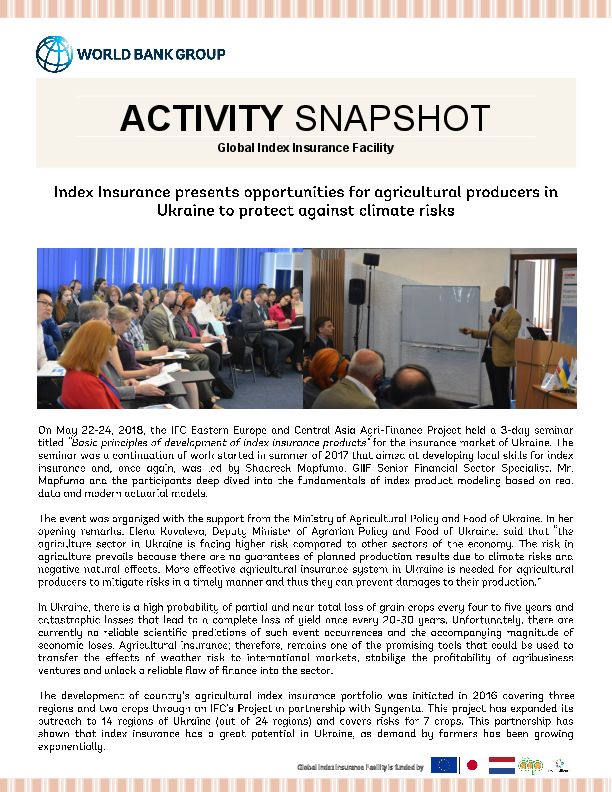Index Insurance presents opportunities for agricultural producers in Ukraine to protect against climate risks

On May 22-24, 2018, the IFC Eastern Europe and Central Asia Agri-Finance Project held a 3-day seminar titled “Basic principles of development of index insurance products" for the insurance market of Ukraine. The seminar was a continuation of work started in summer of 2017 that aimed at developing local skills for index insurance and, once again, was led by Shadreck Mapfumo, GIIF Senior Financial Sector Specialist. Mr. Mapfumo and the participants deep dived into the fundamentals of index product modeling based on real data and modern actuarial models.
The event was organized with the support from the Ministry of Agricultural Policy and Food of Ukraine. In her opening remarks, Elena Kovaleva, Deputy Minister of Agrarian Policy and Food of Ukraine, said that “the agriculture sector in Ukraine is facing higher risk compared to other sectors of the economy. The risk in agriculture prevails because there are no guarantees of planned production results due to climate risks and negative natural effects. More effective agricultural insurance system in Ukraine is needed for agricultural producers to mitigate risks in a timely manner and thus they can prevent damages to their production.”
In Ukraine, there is a high probability of partial and near total loss of grain crops every four to five years and catastrophic losses that lead to a complete loss of yield once every 20-30 years. Unfortunately, there are currently no reliable scientific predictions of such event occurrences and the accompanying magnitude of economic loses. Agricultural insurance; therefore, remains one of the promising tools that could be used to transfer the effects of weather risk to international markets, stabilize the profitability of agribusiness ventures and unlock a reliable flow of finance into the sector.
The development of country’s agricultural index insurance portfolio was initiated in 2016 covering three regions and two crops through an IFC’s Project in partnership with Syngenta. This project has expanded its outreach to 14 regions of Ukraine (out of 24 regions) and covers risks for 7 crops. This partnership has shown that index insurance has a great potential in Ukraine, as demand by farmers has been growing exponentially.
Algorithm for modeling index products
During the seminar, the participants worked out a series of exercises on the designing of index products based on simulation data, and then applied the algorithms with the data from Ukraine. The exercises began with the simplest model in which the insurance coverage is based on one weather parameter. The participants then incrementally worked on the next challenge that entailed a more complicated model than the one before. The exercises, and subsequent discussions around them, touched on various types of index models such as index on dry days, index on dry days during the germination phase, index on aggregate rainfall and drought during the germination phase, three-phase index aggregate rainfall and drought, ten-day drought index, drought composite index, and weighted index of drought. With the development of recent technology that improved weather data and data quality and its accessibility, the issue of basis risk can be minimized. Better data leads to more accurate triggers and better-priced index insurance products. This results in higher quality insurance offers for agricultural producers.
Each participant received electronic worksheets and worked out index algorithms on their personal computers. The most important facet of the seminar for the participants was to learn the key principles of designing index insurance products so that they can create such offerings for Ukrainian farmers suitable for their respective regions, cultures, weather risks, and responsive to the aggregation of available weather data. It is hoped that the development of high quality and affordable index insurance products will help reduce agricultural risks for farmers, and, consequently, increase access to finance for agricultural producers in Ukraine.
